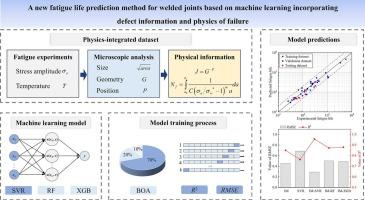A new fatigue life prediction method for welded joints based on machine learning incorporating defect information and physics of failure
IF 6.8
2区 材料科学
Q1 ENGINEERING, MECHANICAL
引用次数: 0
Abstract
This study is dedicated to establishing a new fatigue life prediction model for welded joints that comprehensively considers the effect of welding defects and the physical mechanism of fatigue failure. Firstly, an improved fatigue model for welded joints based on damage tolerance concept is proposed, in which fatigue-critical factors such as the geometric characteristics and location of welding defects are fully considered. Secondly, the proposed physical model is incorporated into a popular machine learning approach of support vector regression (SVR) that is suitable for training fatigue test data, such that a physics-guided artificial intelligence (AI) method is established. The developed method was then applied to predict the fatigue life of welded joints of GH4169 nickel-based superalloy under different fatigue testing conditions at high temperatures. The experimental results show that the life prediction accuracy of the proposed physics-integrated SVR method is significantly higher than that of purely physics-based or purely data-driven methods. Moreover, the proposed method also exhibits better prediction capacity and applicability compared with other physics-AI hybrid methods for fatigue assessment of defect-containing welded joints. This is supported by the fatigue mechanism confirmed by fractographic analysis, demonstrating the promising potential of this physics-integrated AI approach in fatigue life prediction.

结合缺陷信息和失效物理的基于机器学习的焊接接头疲劳寿命预测方法
本研究致力于建立一种综合考虑焊接缺陷影响和疲劳失效物理机制的焊接接头疲劳寿命预测新模型。首先,提出了一种基于损伤容限概念的改进焊接接头疲劳模型,该模型充分考虑了焊接缺陷的几何特征和位置等疲劳关键因素;其次,将提出的物理模型与目前流行的适合训练疲劳试验数据的支持向量回归(SVR)机器学习方法相结合,建立物理引导人工智能(AI)方法。应用该方法对GH4169镍基高温合金焊接接头在不同高温疲劳试验条件下的疲劳寿命进行了预测。实验结果表明,该方法的寿命预测精度明显高于单纯基于物理或单纯数据驱动的方法。此外,与其他物理-人工智能混合方法相比,该方法对含缺陷焊接接头的疲劳评估具有更好的预测能力和适用性。断口分析证实了疲劳机制,证明了这种物理集成人工智能方法在疲劳寿命预测方面的巨大潜力。
本文章由计算机程序翻译,如有差异,请以英文原文为准。
求助全文
约1分钟内获得全文
求助全文
来源期刊

International Journal of Fatigue
工程技术-材料科学:综合
CiteScore
10.70
自引率
21.70%
发文量
619
审稿时长
58 days
期刊介绍:
Typical subjects discussed in International Journal of Fatigue address:
Novel fatigue testing and characterization methods (new kinds of fatigue tests, critical evaluation of existing methods, in situ measurement of fatigue degradation, non-contact field measurements)
Multiaxial fatigue and complex loading effects of materials and structures, exploring state-of-the-art concepts in degradation under cyclic loading
Fatigue in the very high cycle regime, including failure mode transitions from surface to subsurface, effects of surface treatment, processing, and loading conditions
Modeling (including degradation processes and related driving forces, multiscale/multi-resolution methods, computational hierarchical and concurrent methods for coupled component and material responses, novel methods for notch root analysis, fracture mechanics, damage mechanics, crack growth kinetics, life prediction and durability, and prediction of stochastic fatigue behavior reflecting microstructure and service conditions)
Models for early stages of fatigue crack formation and growth that explicitly consider microstructure and relevant materials science aspects
Understanding the influence or manufacturing and processing route on fatigue degradation, and embedding this understanding in more predictive schemes for mitigation and design against fatigue
Prognosis and damage state awareness (including sensors, monitoring, methodology, interactive control, accelerated methods, data interpretation)
Applications of technologies associated with fatigue and their implications for structural integrity and reliability. This includes issues related to design, operation and maintenance, i.e., life cycle engineering
Smart materials and structures that can sense and mitigate fatigue degradation
Fatigue of devices and structures at small scales, including effects of process route and surfaces/interfaces.
 求助内容:
求助内容: 应助结果提醒方式:
应助结果提醒方式:


